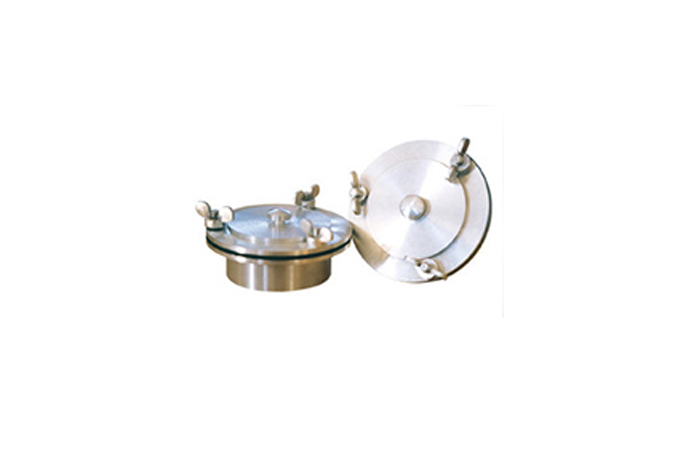【Technical description of the instrument】
Uses: The breathable cup is used to measure the moisture permeability of various fabrics, including moisture-permeable coated fabric plastics, films, etc.
Structural principle: The breathable cup is made of aluminum alloy and sealed with a rubber gasket.
Place the moisture-permeable cup filled with moisture absorbent or water-sealed fabric sample in a sealed environment at a specified temperature,
Calculate the moisture permeability according to the change in the mass of the moisture permeable cup (including the sample and the moisture absorbent or water) within a certain period of time.
【Applicable standards】
GB/T12704-1991, GB1037-88, GB/T2679.3-1995
【Technical Index】
1. The cup body, pressure ring, cup cover, bolt and nut of the YM-11 fabric moisture permeable cup are made of high-quality aluminum alloy.
2. The gasket is made of silicone rubber sheet.
3. The inner diameter of the breathable cup: Φ60mm, the cup depth: 22 mm, and the wall thickness: 3mm.
4. The outer diameter of the upper edge of the moisture-permeable cup: Φ90mm, the thickness of the upper edge of the moisture-permeable cup: 3mm
Instructions:
Method A-moisture absorption method
1. Put the hygroscopic agent into the clean and dry cup. The hygroscopic agent should form a plane, and the filling height of the hygroscopic agent should be 3-4mm from the lower surface of the sample.
2. Place the sample on the cup with the test side facing up, install the washer and pressure ring, screw on the nut, and then seal the test assembly composed of the cup, rubber washer, and pressure ring from the side with vinyl tape.
3. Quickly place the test assembly horizontally in a test box that has reached a temperature of 38°C, a humidity of 90°C, and an airflow velocity of 0.3-0.5m/s, and takes it out after 0.5h of equilibrium.
4. Quickly cover the corresponding cup lid, put it in a silica gel dryer at about 20℃ for 0.5h, and weigh one by one according to the number, accurate to 0.001g, and the weighing time of each test combination should not exceed 30s.
5. Remove the lid of the cup, quickly put the test assembly into the oven, take it out after the 1h test, and weigh it in accordance with 4. The order of weighing the test assembly should be the same each time.
Method B-Evaporation Method
1. Pour 10 mL of water into a clean, dry cup.
2. Place the test sample face down on the cup, install the washer and pressure ring, screw on the nut, and then seal the test assembly composed of the cup, rubber washer, and pressure ring from the side with vinyl tape.
3. Place the test assembly horizontally in a test box that has reached a temperature of 38°C, a humidity of 2°, and an airflow velocity of 0.5m/s. After 0.5h of balance, weigh it in the box one by one according to the number to the nearest 0.001g.
4. After the 1h test, weigh again in the same order. If it needs to be weighed outside the box, the difference between the ambient temperature and the specified test temperature during weighing shall not exceed 3°C.
The moisture permeability of the sample is calculated as follows:
In the formula: WVT per square meter per day moisture permeability.g/(m2.d)
△m The difference between the second weighing of the same test combination.g
sSample test area.m2
t Test time.t
The moisture permeability is the arithmetic mean of the moisture permeability of the three samples [rounded to 10g/(m2.d)].
 Service hotline:
Service hotline: Receipt mail:
Receipt mail:

